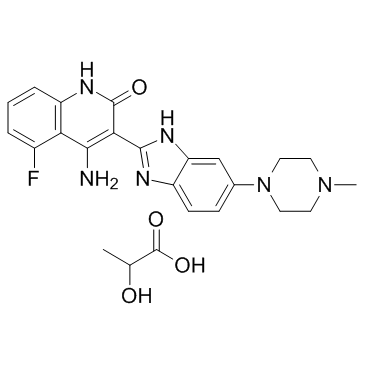692737-80-7
| Name | 4-Amino-5-fluoro-3-(6-(4-methylpiperazin-1-yl)-1H-benzo-[d]imidazol-2-yl)quinolin-2(1H)-one 2-hydroxypropanoate |
|---|---|
| Synonyms |
2-Hydroxypropanoic acid - 4-amino-5-fluoro-3-[5-(4-methyl-1-piperazinyl)-1H-benzimidazol-2-yl]-2(1H)-quinolinone (1:1)
Propanoic acid, 2-hydroxy-, compd. with 4-amino-5-fluoro-3-[6-(4-methyl-1-piperazinyl)-1H-benzimidazol-2-yl]-2(1H)-quinolinone (1:1) UNII:B82T791274 Dovitinib Lactate |
| Description | Dovitinib(CHIR-258; TKI258) lactate is a potent inhibitor of fibroblast growth factor receptor 3 (FGFR3) with an IC50 of 5 nM. |
|---|---|
| Related Catalog | |
| Target |
FGFR3:5 nM (IC50) |
| In Vitro | Dovitinib potently inhibits FGFR3 with an IC50 of 5 nM in in vitro kinase assays and selectively inhibits the growth of B9 cells and human myeloma cell lines expressing wild-type or activated mutant FGFR3. Addition of interleukin 6 (IL-6) or insulin growth factor 1 or coculture on stroma does not confer resistance to dovitinib. In primary myeloma cells dovitinib inhibits downstream extracellular signal-regulated kinase (ERK) 1/2 phosphorylation with an associated cytotoxic response[1]. Treatment of SK-HEP1 cells with dovitinib results in G2/M cell cycle arrest, inhibition of colony formation in soft agar and blockade of bFGF-induced cell migration. Dovitinib inhibits basal expression and FGF-induced phosphorylation of FGFR-1, FRS2-α and ERK1/2[2]. |
| In Vivo | Dovitinib demonstrates significant antitumor and antimetastatic activities in HCC xenograft models. Dovitinib potently inhibits tumor growth of six HCC lines. Inhibition of angiogenesis correlates with inactivation of FGFR/PDGFR-β/VEGFR-2 signaling pathways. Dovitinib also causes dephosphorylation of retinoblastoma, upregulation of p-histone H2A-X and p27, and downregulation of p-cdk-2 and cyclin B1, which results in a reduction in cellular proliferation and the induction of tumor cell apoptosis[2]. |
| Cell Assay | To determine IC50 for SK-HEP1 cells, cells are plated at a density of 2×104 cells per dish. After 48 h, cells are treated with 0, 0.01, 0.1, 1, 5, 10, 50, 100 μM dovitinib in DMEM containing 1% FBS for 24 h. Cell viability is determined with Cell Proliferation Assay. IC50 is calculated by nonlinear regression analysis using GraphPad Prism software[2]. |
| Animal Admin | Mice: Six HCC lines (06-0606, 26-0808A, 26-1004, 25-0705A, 5-1318, 21-0208) are used to establish tumors in male SCID mice. or dose-esponse experiments, mice bearing the 06-0606 xenografts re orally given vehicle (5% dextrose) or two doses of dovitinib (50 and 75 mg/kg) daily for 14 days. For time-dependent inhibition of dovitinib targets, mice bearing 06-0606 tumors are given orally 200 μL of either vehicle (n=6) or 50 mg/kg/day of dovitinib (n=10)[2]. |
| References |
| Molecular Formula | C24H27FN6O4 |
|---|---|
| Molecular Weight | 482.507 |
| Exact Mass | 482.207794 |
| PSA | 151.57000 |
| LogP | 2.58040 |
| Storage condition | 2-8℃ |
